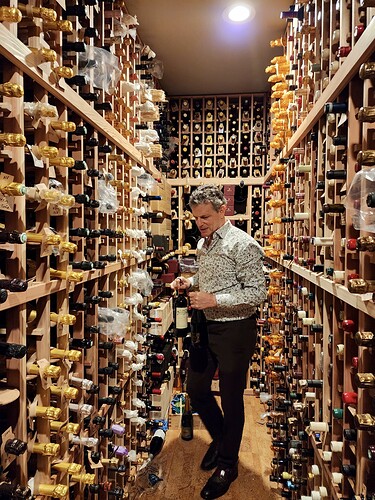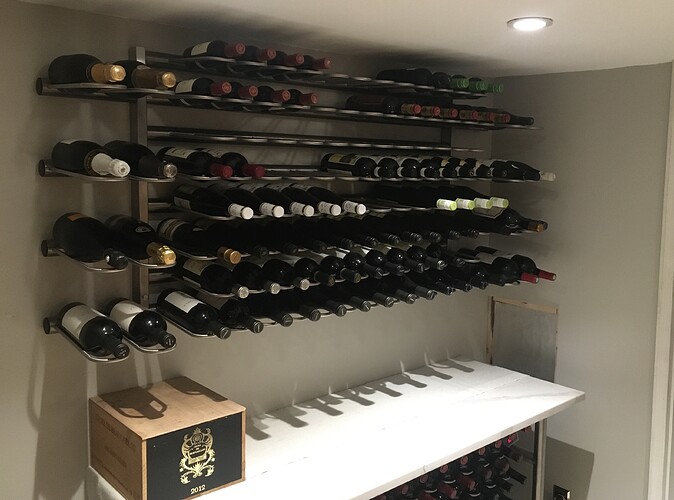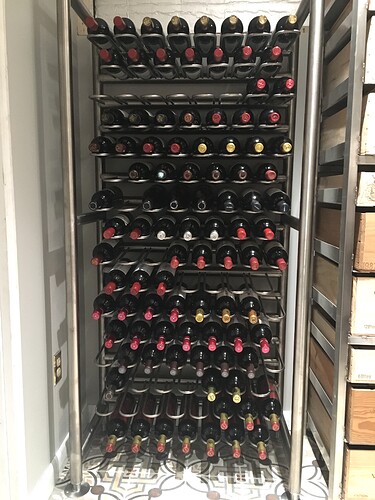If you’re wanting to maximize capacity with the common lattice-style racks, you’ll want to put racking on both long walls, with an aisle between. Looking at Wine Racks of America, it looks like you could fit 46 columns on each wall. With extenders to the ceiling, you could fit around 2200 bottles.
happy with my cellar, but I would definitely make the boxes for 6 and 12 bottles larger for these modern huge bottles that won´t fit it normally -
and a special department for my Franken bottles (Bocksbeutel) which I now can only store in extra boxes -
How do you like Vigilant? I’m considering them for my wine cellar. Did they install anything for you?
Any issues?
Thanks
They did not do the install. I used their kits which required assembly. I drove to them and picked up which saved quite a bit considering size and weight. Good quality and easy to work with.
@Brian_S_t_o_t_t_e_r, someone just flagged this old post. We’ve since moved, and my cellar was upgraded. Despite my own advice, I still don’t have quite enough racking to accommodate all of my champagne bottles.
@Nathan_Smyth, we’re still in the Cascadia subduction zone. This cellar is a little safer than my last one, but in a significant earthquake, it’ll be a mess. I’ll have bigger things to worry about should that happen in my lifetime.
The right side of the cellar is double deep. I’ve used a rubber band safety strap that I think @alan_weinberg described, and the racks are bolted to studs. They won’t fall unless the walls do.
Cheers
Warren
Hi Warren,
I’m in the same zone and have the same “we’ll have bigger things to worry about” camp. After all, the prediction is a 9.0. That said, what are the rubber bands you used? I’ve been thinking of getting some.
Thanks.
Thread drift alert: this fantastic New Yorker article posits that the next “big one” will occur in Seattle, not Los Angeles.
“Fantastic” is not the word that comes to mind.
Touche’. And I do hope touche’ is the maximum damage.
(Seriously though, the historical forensics in the NY article are fab- awe-, er, very interesting to the reader.)
Vigilant did the racking for my cellar and I was very happy with them. I sent them the dimensions and a rough idea of what I wanted, they sent back a design, we went back and forth a few times, and then they built it and shipped it. No issues. My contractor assembled and installed it (if there were any major issues during installation, they didn’t mention it to me).
Later I needed to add a bit more racking to work around a frustrating problem with the cooling unit, and again Vigilant was easy to work with and got it turned around very quickly.
They were not the cheapest, but I’d definitely work with them again.
In terms of what I’d do differently, it’s only two things:
- Buy a different cooling unit, because the Wine Guardian I bought ended up not working for my install, and the company was a pain to work with.
- Put in less magnum racking. I barely put in any as it is, but I use almost none of it. I never buy mags, and all Champagne except Krug and one or two other things fit in the regular racks. So it just ends up being wasted space.
I guess an honorary mention is I’d like to have a small amount of table/shelf space to use while organizing and doing inventory. But I had that in the original design, and lost it when I had to change racking to accommodate the suboptimal cooling unit situation.
So what do people recommend then for the cooling unit? I see refs to a split system but I’m not sure what that means. Does the cooler also control humidity or is that a separate unit again?
A split system has a separate condenser and evaporator, instead of having both combined in one unit. One sits outside like your central a/c unit, the other is in the cellar. Costs more but (they say) breaks down less, plus - this is often the biggest advantage - doesn’t require venting from the cellar into an adjacent room. The one I have does “control” humidity within a range but can only do so much. Particularly if you want to add humidity you still may need a separate humidifier. Mine also requires a drain line which my old self-contained units did not, so that’s a minus (as is the cost), compared to self-contained.
Here’s an example of a split system:
Adding to this, you can just go down to Home Depot and buy one, rather than ordering from a specialty supplier. It’s also why local HVAC contractors can service them. They are made by big-name manufacturers like Mitsubishi and LG in quantity, keeping the price relatively reasonable; the wine cellar specific units have gone up in price enough that the commodity split units aren’t that much more. But you have to connect a custom thermostat “coolbot” controller to fake it out so it will cool to 55 rather than stop at the 60s.
Re the venting point, does that matter if the cellar has outside walls? ie I can easily vent directly outside through the external wall?
Ideally your cellar is below grade, so your outside walls have earth on the other side and can’t be used for venting.
If you are building above grade, then having an outside wall makes the venting issue with a sealed unit more convenient for sure. What I don’t know is whether there are temperature-differential limits that would impact this option. It could well be that if outside temps get above X then using the exterior wall to vent your sealed unit would not be an option.


